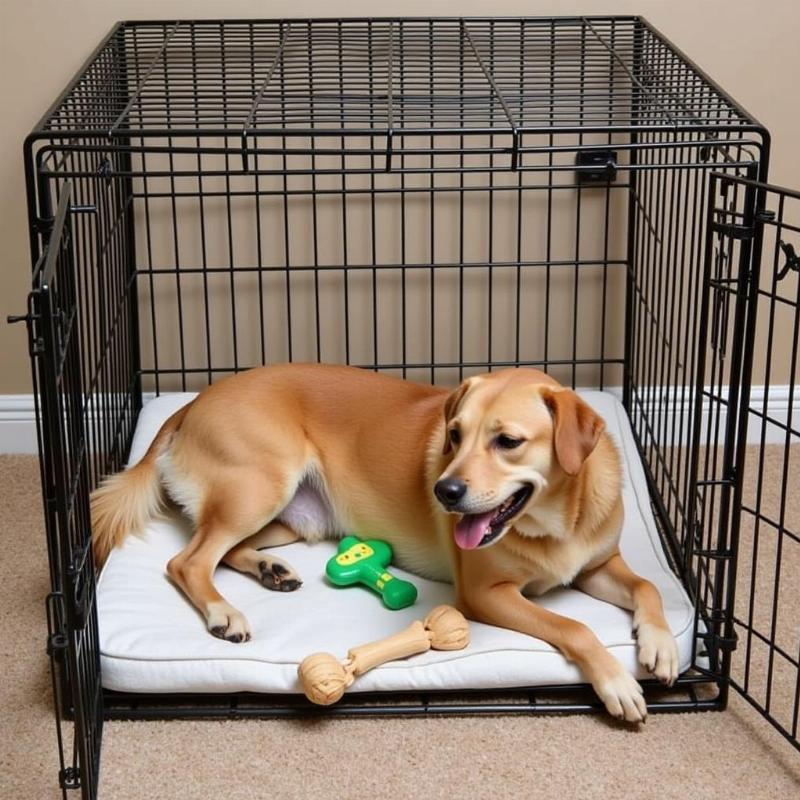Crate training can be a wonderful tool for housebreaking, providing a safe space, and managing your dog’s behavior. However, it can be frustrating when your dog keeps escaping his crate. This article will delve into the reasons why your dog might be breaking out, and offer practical solutions to help you address this common issue and create a positive crate training experience. We’ll cover everything from choosing the right crate to understanding your dog’s behavior and ensuring their safety and well-being.
Why Is My Dog Escaping His Crate?
There are several reasons why a dog might be motivated to escape their crate. Understanding the root cause is crucial to finding the right solution. Is your dog bored, anxious, or simply needing to go potty? Are they a Houdini-like escape artist, or is the crate itself not secure? Let’s explore some common culprits.
Separation Anxiety and Crate Escape
Separation anxiety can manifest as destructive behavior, excessive barking, and yes, even crate escapes. Dogs experiencing separation anxiety become distressed when left alone, and the confinement of the crate can exacerbate this.
Boredom and Lack of Stimulation
A bored dog is a dog looking for trouble. If left in their crate for extended periods without mental or physical stimulation, they might resort to escaping to find something to do.
Potty Breaks and Crate Training
If your dog is still being house-trained, they might be escaping because they need to relieve themselves. A consistent potty schedule is essential during crate training.
Crate Size and Comfort
An improperly sized crate can also contribute to escape attempts. A crate that is too small will be uncomfortable, while one that’s too large might allow your dog to create a separate “potty area” and eliminate inside.
Solutions to Stop Your Dog from Escaping the Crate
Now that we understand some of the reasons behind crate escapes, let’s dive into the solutions. Remember, patience and consistency are key.
Choosing the Right Crate
Ensure your dog’s crate is the right size. They should be able to stand, turn around, and lie down comfortably. A crate that is too large can be problematic, so choose one that fits their needs without excessive extra space. Consider the material and construction of the crate as well. A sturdy, well-built crate will be more difficult to escape from.
Creating a Positive Crate Environment
Make the crate a positive and inviting space. Add comfortable bedding, their favorite toys, and even a safe chew toy. Consider covering the crate with a blanket to create a den-like atmosphere.
Establishing a Potty Routine
If your dog is escaping to relieve themselves, establish a consistent potty schedule. Take them out regularly, especially before and after crate time. Reward successful potty breaks outside the crate.
Addressing Separation Anxiety
If separation anxiety is the culprit, gradual desensitization and counter-conditioning can help. Start by leaving your dog in the crate for short periods while you’re still in sight. Gradually increase the duration as they become more comfortable.
 Dog in a Comfortable Crate with Toys
Dog in a Comfortable Crate with Toys
Mental and Physical Enrichment
Provide plenty of mental and physical stimulation before crate time. A tired dog is less likely to try to escape. Consider a long walk, a game of fetch, or a puzzle toy.
Crate Training Techniques
Reinforce positive associations with the crate. Feed your dog their meals in the crate, and offer treats and praise when they enter calmly. Never use the crate as punishment.
Conclusion
Addressing crate escape issues requires patience, understanding, and a tailored approach. By identifying the underlying cause and implementing the appropriate solutions, you can help your dog feel safe and secure in their crate, making it a positive experience for both of you. Remember, a crate should be a haven, not a prison.
FAQ
-
How do I know if my dog’s crate is the right size? Your dog should be able to stand, turn around, and lie down comfortably.
-
What if my dog continues to escape despite my efforts? Consult with a certified professional dog trainer or veterinarian behaviorist.
-
Can I use a crate for punishment? No, never use the crate as punishment. It should be a positive and safe space.
-
How long can I leave my dog in the crate? It depends on your dog’s age and individual needs. Consult with your veterinarian for guidance.
-
What are some signs of separation anxiety in dogs? Destructive behavior, excessive barking, pacing, and escape attempts when left alone.
-
Should I cover my dog’s crate? Some dogs find it comforting, while others may find it stressful. Observe your dog’s behavior to determine their preference.
-
What kind of toys should I put in my dog’s crate? Durable chew toys, puzzle toys, and soft comfort toys are good options.
Beautdogs.us is your premier resource for all things dog-related in the US. We offer expert advice on dog breeds, care, and products, catering to both novice and experienced dog owners. Our mission is to empower you to provide the best possible care for your furry friend. For personalized guidance, contact us via email at [email protected] or call us at +1 501-555-7529. Visit Beautdogs.us today for more valuable insights and resources!